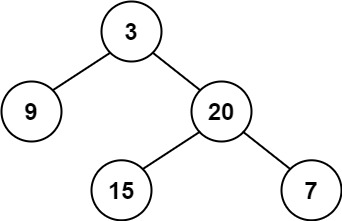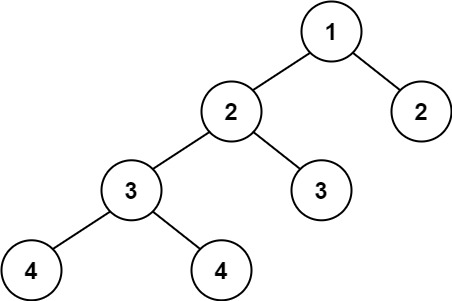58. Balanced Binary Tree
Problem Statement
Given a binary tree, determine if it is height-balanced.
For this problem, a height-balanced binary tree is defined as:
a binary tree in which the left and right subtrees of every node differ in height by no more than 1.
Example 1:

Input: root = [3,9,20,null,null,15,7] Output: true
Example 2:

Input: root = [1,2,2,3,3,null,null,4,4] Output: false
Example 3:
Input: root = [] Output: true
Solution
# Definition for a binary tree node.
class TreeNode:
def __init__(self, val=0, left=None, right=None):
self.val = val
self.left = left
self.right = right
class Solution:
def isBalanced(self, root: TreeNode) -> bool:
def dfs_height_check(node):
if not node:
return 0 # Height of an empty tree is 0
left_height = dfs_height_check(node.left)
if left_height == -1: # Left subtree is unbalanced
return -1
right_height = dfs_height_check(node.right)
if right_height == -1: # Right subtree is unbalanced
return -1
# Check if current node is balanced
if abs(left_height - right_height) > 1:
return -1
# Return the height of the current subtree
return 1 + max(left_height, right_height)
return dfs_height_check(root) != -1
Explanation
This problem can be solved efficiently using a recursive Depth-First Search (DFS) approach. The key is to check the balance condition while simultaneously calculating the height of each subtree.
Core Idea: We need to check two things for each node:
- Its left subtree is balanced.
- Its right subtree is balanced.
- The absolute difference between the heights of its left and right subtrees is no more than 1.
Recursive dfs_height_check Function:
-
This function returns the height of the subtree rooted at
nodeif it's balanced, and-1if it's unbalanced. -
Base Case: If
nodeisNone, its height is 0, and it's considered balanced. Return 0. -
Recursive Calls:
- Recursively call
dfs_height_checkon thenode.leftto getleft_height. - Recursively call
dfs_height_checkon thenode.rightto getright_height.
- Recursively call
-
Check for Unbalanced Subtree: If
left_heightorright_heightis-1, it means one of the subtrees is already unbalanced. In this case, the entire tree rooted atnodeis also unbalanced, so we propagate the-1up. -
Check Current Node's Balance: If both subtrees are balanced, we then check if the current
nodeitself is balanced by comparingabs(left_height - right_height). If the difference is greater than 1, return-1. -
Return Height: If all checks pass, the current subtree is balanced, and its height is
1 + max(left_height, right_height).
Main Function: The isBalanced function simply calls dfs_height_check on the root and returns True if the result is not -1, indicating a balanced tree.
Time and Space Complexity:
- Time Complexity: O(N), where N is the number of nodes in the binary tree. Each node is visited exactly once.
- Space Complexity: O(H) in the worst case, where H is the height of the tree, due to the recursion stack. In a skewed tree, H can be N (O(N)), and in a balanced tree, H is log N (O(log N)).